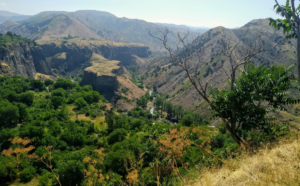Treasures of Arevik National Park

Arevik National Park
We are continuing our discoveries of green destinations of Armenia, as promised. This time we offer you to explore treasures of Arevik National Park. Here are some facts and figures of interest.
Location: Arevik is in South Armenia, in Syunik Province
Size: 34,402 hectares
Altitude of the terrain: 450 m – 3,500 m
Year of establishment of the National Park: 2009
Landscape: Broadleaf forests, juniper open woodlands, subalpine and alpine meadows, semi-deserts, mountain steppes, rivers, high-mountains
Flora: Juniper, oak, hornbeam, maple, ash
Fauna: Caucasian leopard, bezoar goat, brown bear, otter, Caspian snowcock, Caucasian black grouse, Armenian mouflon, colchic pheasant, striped hyena, Armenian viper, Mediterranean turtle
Arevik National Park is an important location for protection of endangered and rare species such as the Caucasian leopard, the Armenian mouflon, and the Mediterranean turtle. Oak and juniper forests cover more than two-thirds of the National Park. But there are also semi-deserts, mountain plains, and alpine meadows, and an extraordinary diversity of flowers. The ecology of Arevik National Park reflects its location: it is close to the border region, in the very south of the country, where Iranian, Anatolian, and Caucasian and Central Asian fauna come together, making it a particularly interesting place to visit from an ecological point of view.
Nature
Visitors to Arevik can enjoy unique and beautiful mountain sceneries with the park’s specific biodiversity. The region also has a rich historical-cultural heritage to offer. Tourists can observe various species of the National Park like the bezoar goat, one of its protected and precious representatives, and also a wide range of different bird species like quail, partridge, eagle, and falcon. The Araks River is rich with fish. The best time to visit the National Park is from June to October. The park can be explored on foot or on horseback. However, getting there will sometimes require an off-road vehicle.
Local Products
The charming town of Meghri at the Iranian border is known as the “sweet part of Armenia”. Due to the moderate subtropical climate with hot summers and mild winters delicious fruits are grown here. Figs, pomegranates, persimmons, and kiwis grow lavishly in abundant orchards. The sweet temptations produced by local factories will not let any visitor leave this region without bringing home some sweet memories such as a bottle of the famous pomegranate wine. However, it is not only culinary delights which the town of Meghri has to offer. Discover Meghri’s churches, monastery, and fortress during the morning hours, when early birds swarm over the silhouette of ruins and the landscape is immersed in a warm and glowing orange light.
Did you know … that the leopards were still abundant in the Caucasus until the early twentieth century? However, their survival has been jeopardized by various threats like poaching, military action, and deforestation. The Iranian region, bordering Arevik National Park, is considered to be today’s main source area of the Caucasian leopard. Well-managed protected areas and trans-boundary “habitat corridors” in the Caucasus countries play a key role in boosting the survival of the big cat.
Tags: National Parks, State Reserves




